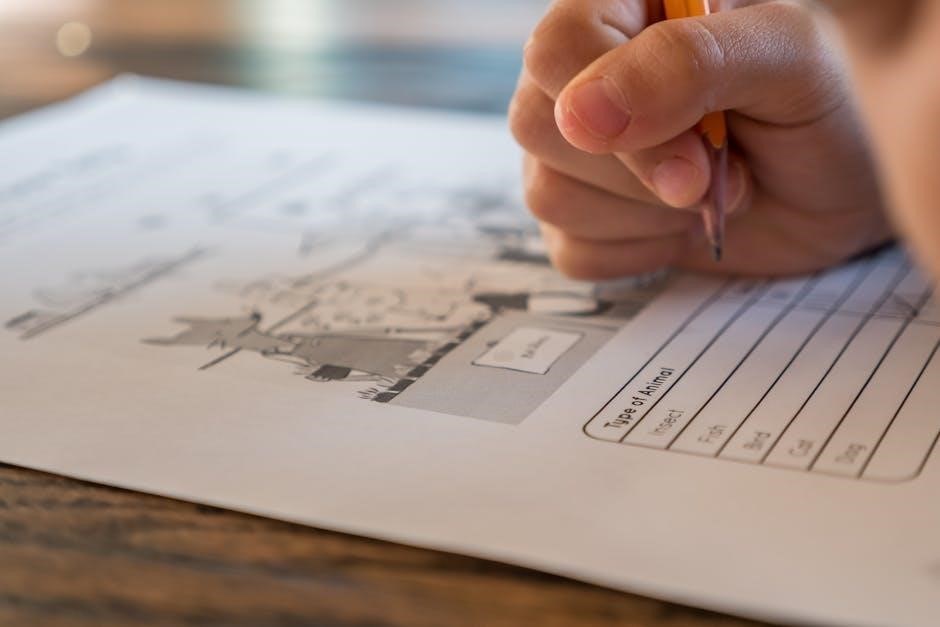classroom hand signals pdf free
Classroom hand signals are non-verbal communication tools enhancing learning environments. They minimize interruptions‚ encourage engagement‚ and support inclusive classrooms. Download free PDF posters to implement these effective cues easily.
What Are Classroom Hand Signals?
Classroom hand signals are non-verbal cues used by students and teachers to communicate without disrupting the learning environment. These gestures‚ such as raising hands‚ waving fingers‚ or making specific shapes‚ convey messages like needing assistance‚ asking to use the restroom‚ or signaling agreement. They are simple‚ effective‚ and universal‚ ensuring clear communication in diverse classroom settings.
These signals are often displayed as posters in classrooms‚ serving as visual reminders for students. They promote organization‚ reduce interruptions‚ and foster a focused atmosphere. Teachers can customize hand signals to meet specific classroom needs‚ making them adaptable for various age groups and learning environments. Free downloadable PDFs are widely available‚ offering pre-designed signals that can be printed and used immediately.
The Importance of Non-Verbal Communication in Classrooms
Non-verbal communication‚ such as hand signals‚ plays a crucial role in maintaining a structured and respectful classroom environment. It helps minimize disruptions‚ allowing lessons to flow smoothly and ensuring students remain focused. By using gestures‚ teachers can address needs without interrupting instruction‚ fostering a culture of respect and efficiency. These signals are especially beneficial for students who may struggle with verbal communication‚ creating an inclusive space for all learners.
Free downloadable resources‚ like PDF posters‚ make it easy for educators to implement hand signals. These tools promote consistency and clarity‚ helping students understand expectations and communicate effectively. Non-verbal cues also support diverse learners‚ ensuring everyone can participate fully in classroom activities.
How Hand Signals Enhance Classroom Management
Hand signals are a powerful tool for maintaining order and efficiency in classrooms. They reduce interruptions‚ allowing teachers to focus on instruction while students can communicate silently. By establishing clear‚ consistent gestures‚ educators create a predictable environment where expectations are understood. This fosters respect and accountability among students. Hand signals also support students with special needs by providing a reliable method of communication. They encourage self-regulation and independence‚ reducing reliance on verbal cues. Additionally‚ signals help manage transitions and group activities smoothly‚ minimizing chaos. With free downloadable resources like PDF posters‚ teachers can easily implement these cues‚ ensuring a calm and focused learning space for all students.

Benefits of Using Hand Signals in the Classroom

Hand signals minimize disruptions‚ encourage engagement‚ and support students with special needs. They promote a focused environment and ensure clear communication‚ making teaching more efficient and effective.
Minimizing Interruptions and Distractions
Hand signals are a powerful tool for reducing interruptions and distractions in the classroom. By using non-verbal cues‚ students can communicate their needs without disrupting lessons‚ allowing teachers to maintain focus. For example‚ a raised hand with a specific gesture can indicate a request for the restroom‚ water‚ or a pencil. This approach ensures that learning remains uninterrupted and students stay engaged. Teachers can also use signals to remind students to stay on task or transition smoothly between activities. With free printable PDF posters‚ educators can easily display these signals‚ teaching students to use them consistently. This method fosters a calm and organized environment‚ making it easier for everyone to concentrate and achieve their educational goals effectively.
Encouraging Student Engagement and Participation
Hand signals are a simple yet effective way to encourage student engagement and participation in the classroom. By using non-verbal cues‚ students can express their thoughts or needs without interrupting lessons‚ fostering an inclusive environment. For instance‚ a signal for “I have a question” or “I agree” allows students to contribute without raising their voices. This method also empowers shy or hesitant students to participate actively. Free printable PDF posters can be displayed to teach these signals‚ ensuring everyone understands their meanings. By incorporating hand signals‚ teachers can create opportunities for all students to feel heard and valued‚ promoting a dynamic and interactive learning atmosphere that supports academic success and social growth. This approach is particularly beneficial for diverse classrooms‚ ensuring every student has a voice.
Supporting Students with Special Needs
Hand signals are a lifeline for students with special needs‚ providing clear‚ consistent‚ and non-verbal communication. They minimize reliance on verbal instructions‚ which can be challenging for some students. For example‚ a signal for “I need help” or “I need to use the restroom” ensures students can communicate their needs discreetly. This reduces anxiety and encourages independence. Additionally‚ hand signals help students with sensory sensitivities by avoiding loud or sudden verbal commands. Free PDF posters with visual aids can be especially helpful for students who benefit from visual supports. By incorporating hand signals‚ teachers create an inclusive environment where all students‚ including those with special needs‚ can thrive and participate confidently.
Fostering a Quiet and Focused Learning Environment
Hand signals are a powerful tool for maintaining a quiet and focused classroom. By using non-verbal cues‚ teachers can address student needs without interrupting lessons. For example‚ a signal for “raise your hand” ensures students wait to speak‚ minimizing disruptions. Similarly‚ a “quiet please” gesture helps refocus the class quickly. These signals create a calm atmosphere‚ allowing students to concentrate on their work. Free PDF posters with clear visuals make it easy to teach and reinforce these cues. Consistent use of hand signals promotes a structured environment‚ helping students stay engaged and respectful. This approach not only enhances focus but also fosters a sense of discipline and mutual respect among everyone in the classroom.

Common Classroom Hand Signals
Classroom hand signals are essential for managing student needs non-verbally. Common signals include requests like restroom‚ water‚ or pencil‚ and actions like raise hand or quiet. Free PDF posters outline these cues clearly for easy implementation.
Basic Hand Signals for Everyday Use
Basic hand signals are simple‚ non-verbal cues that students and teachers use daily. They include gestures for common needs like restroom‚ water‚ or pencil requests. These signals minimize disruptions‚ allowing learning to continue uninterrupted. Teachers can print free PDF posters featuring clear visuals of these signals‚ ensuring everyone understands their meaning. For example‚ holding up a hand with fingers spread might mean “I have a question‚” while a thumb-and-index finger shape could signal “I need a pencil.” Consistency is key‚ so teaching these signals at the start of the school year helps establish a smooth classroom routine. These resources are readily available online‚ making it easy to implement this effective communication strategy.
Signals for Common Requests (e.g.‚ Restroom‚ Water‚ Pencil)
Hand signals for common requests‚ such as restroom‚ water‚ or pencil‚ are essential for maintaining classroom flow. These signals allow students to communicate their needs without verbal interruptions. For example‚ a cupped hand may indicate “I need water‚” while a writing motion with the hand can signal “I need a pencil.” Teachers can download free PDF posters featuring these signals‚ ensuring clarity and consistency. Displaying these posters in the classroom helps students remember the gestures and use them appropriately. This system not only reduces disruptions but also teaches students responsibility and self-advocacy. By establishing these signals early‚ educators create a respectful and efficient learning environment. Consistency is key to ensuring everyone understands and uses the signals correctly.
Signals for Classroom Actions (e.g.‚ Raise Hand‚ Quiet‚ Attention)
Hand signals for classroom actions‚ such as raising hands‚ signaling quiet‚ or requesting attention‚ are fundamental for maintaining order and focus. For instance‚ a raised hand with palm facing outward often means “I need to speak‚” while a closed fist might indicate “Be quiet.” These signals are simple‚ universal‚ and effective. Teachers can use them to manage transitions‚ group work‚ or whole-class discussions seamlessly. By teaching students these gestures‚ educators create a structured environment where everyone knows the expectations. Free downloadable PDF posters are available to display these signals prominently‚ ensuring consistent use. This non-verbal system fosters respect‚ reduces chaos‚ and allows learning to thrive uninterrupted. Consistency and clear communication are key to their success in any classroom setting.
Signals for Group Activities and Transitions
Hand signals for group activities and transitions help streamline classroom movements and maintain focus. For example‚ a spinning finger gesture can signal “rotate roles‚” while a walking fingers motion might mean “move quietly.” These cues are especially useful during group work‚ transitions‚ or clean-up. Signals like forming a line or assembling in a specific area ensure order. Teachers can also use gestures to indicate the start or end of an activity‚ reducing confusion. Free PDF posters and editable templates are available online‚ offering customizable signals tailored to classroom needs. By teaching these signals‚ educators create a smooth‚ efficient flow during group tasks and transitions‚ minimizing disruptions and keeping students engaged. Consistency is key to their effectiveness.

How to Implement Hand Signals in Your Classroom

Introduce hand signals as a simple‚ effective classroom management tool. Teach students their meanings‚ display posters‚ and practice regularly to ensure consistency and understanding‚ minimizing disruptions and promoting focus.
Teaching Students the Meaning of Hand Signals
Teaching students the meaning of hand signals is a straightforward process that ensures clarity and consistency. Begin by introducing one signal at a time‚ demonstrating its purpose clearly. Use visual aids like posters or flashcards to reinforce learning. For example‚ show the “raise hand” signal for questions and explain its use. Encourage students to practice the signals in class‚ making it a fun and interactive experience. Consider modeling each signal alongside a verbal explanation to help students connect the gesture with its meaning. Regular practice and positive reinforcement will help students master the signals quickly. Over time‚ this non-verbal communication system becomes second nature‚ fostering a more organized and focused classroom environment. Additionally‚ provide opportunities for students to ask questions and demonstrate their understanding to ensure everyone is on the same page. This approach not only teaches the signals but also promotes discipline and teamwork. By consistently using the same signals‚ you create a predictable and structured learning space where students feel confident and supported. Free downloadable resources‚ such as printable PDFs‚ can also serve as helpful references for both teachers and students‚ ensuring everyone has access to the same visual guides. This method is particularly effective for younger students or those who benefit from visual reminders. By taking the time to teach and reinforce these signals‚ you lay the foundation for a well-managed and engaged classroom. The key is to be patient and consistent‚ allowing students to gradually become comfortable with the new system. As they grow more familiar‚ the signals will become an invaluable tool for maintaining order and encouraging participation without disrupting the flow of instruction. This approach not only enhances classroom management but also empowers students to communicate effectively‚ fostering a sense of responsibility and independence. Overall‚ teaching hand signals is a simple yet powerful strategy that benefits both teachers and students alike‚ creating a more efficient and enjoyable learning experience.
Creating a Consistent System for Classroom Management
Creating a consistent system for classroom management involves establishing clear expectations and routines. Hand signals play a key role in maintaining order and minimizing disruptions. Begin by introducing signals one at a time‚ ensuring students understand their meanings. Display posters in visible locations to serve as reminders. Consistency is crucial—use the same signals daily and across all lessons. Encourage the entire class to participate in practicing the signals‚ making it a shared responsibility. For example‚ use a “quiet” signal to transition between activities seamlessly. Over time‚ students will automatically recognize and respond to these cues‚ fostering a disciplined and focused environment. Regular reinforcement and positive feedback will help maintain this system effectively. By integrating hand signals into daily routines‚ you create a structured and predictable classroom culture that supports learning and reduces chaos. This consistency also helps students feel secure and confident‚ knowing exactly what is expected of them. Ultimately‚ a well-implemented system of hand signals becomes an essential tool for maintaining a well-organized and engaged classroom.
Displaying Hand Signal Posters in the Classroom
Displaying hand signal posters in the classroom is a simple yet effective way to reinforce non-verbal communication. Print the posters on high-quality paper and place them in visible locations‚ such as near the front of the room or on bulletin boards. Choose bright colors and clear images to ensure visibility for all students. Ensure the posters are large enough to be easily seen from any spot in the classroom. For added convenience‚ use free PDF templates or editable Google Slides to customize the designs according to your classroom theme. By prominently displaying these posters‚ students are reminded of the signals daily‚ making it easier for them to remember and use the cues appropriately. This visual aid supports a consistent and organized learning environment‚ helping to minimize distractions and promote smooth transitions throughout the day.
Practicing Signals Regularly for Reinforcement
Regular practice is essential for reinforcing hand signals in the classroom. Dedicate a few minutes each day to review and practice the signals with your students. Start with simple gestures and gradually introduce more complex ones. Use drills‚ games‚ or role-playing activities to make practice engaging. For example‚ you can call out a signal and have students mimic it immediately. Consistency is key to ensuring students remember and use the signals correctly. Encourage students to practice at home by sharing free PDF guides with their families. Positive reinforcement‚ such as praising correct usage‚ will motivate students to participate actively. Regular practice helps create a seamless communication system‚ reducing confusion and ensuring smooth classroom operations.

Free Resources for Classroom Hand Signals
Discover a variety of free PDF posters and editable Google Slides templates for classroom hand signals. These resources offer customizable designs‚ multicultural options‚ and easy-to-print formats to enhance your classroom management system.
Where to Find Free Printable PDFs
Free printable PDFs for classroom hand signals can be found on educational websites like The Science Penguin and Teachers Pay Teachers. These platforms offer a variety of designs‚ including multicultural and editable options. Simply search for “classroom hand signals PDF” and choose from vibrant‚ pre-designed templates. Many resources are available for immediate download‚ allowing you to print and display them in your classroom. These PDFs often include signals for common requests‚ such as restroom breaks or needing a pencil‚ and are designed to minimize disruptions. They also support students with special needs by providing clear‚ visual cues; Download these free resources to create a consistent and inclusive communication system for your students.
Editable Google Slides Templates for Customization
Editable Google Slides templates are an excellent way to customize classroom hand signals to suit your teaching style and classroom theme. These templates allow you to modify colors‚ text‚ and images to create personalized signals that align with your classroom decor. Many free resources‚ such as those found on Teachers Pay Teachers‚ offer editable versions that can be tailored to specific needs. Teachers can also collaborate in real-time to design signals with colleagues. These templates are perfect for creating visual cues that match your classroom environment‚ ensuring consistency and clarity. By customizing hand signals‚ educators can enhance student understanding and engagement‚ making classroom management more effective and inclusive for all learners.
Multi-Cultural and Inclusive Hand Signal Designs
Multi-cultural and inclusive hand signal designs ensure that all students feel represented and valued in the classroom. These designs incorporate diverse imagery‚ colors‚ and symbols to reflect the cultural backgrounds of students. Free resources‚ such as multicultural hand signal posters‚ are available online‚ offering a variety of styles to suit different classroom environments. Inclusive designs also cater to students with special needs‚ ensuring accessibility for all learners. By using culturally responsive visuals‚ teachers promote diversity and create a welcoming atmosphere. These hand signals not only aid in classroom management but also foster a sense of belonging and respect among students. They are an essential tool for building an inclusive and equitable learning environment.

Designing Your Own Hand Signal Posters
Design custom hand signal posters using editable Google Slides templates or printable PDFs. Tailor designs to fit your classroom needs‚ ensuring clarity and effectiveness for your students.
Steps to Create Custom Hand Signal Posters
Creating custom hand signal posters involves selecting a design template‚ such as editable Google Slides or printable PDFs. Choose a layout that fits your classroom style. Customize the content by adding relevant signals‚ labels‚ and images. Use clear fonts and contrasting colors for visibility. Incorporate visuals‚ like hand illustrations or icons‚ to make the signals easy to understand. Ensure the posters align with your classroom management goals. Print the posters on high-quality paper and display them prominently. Regularly review and update the designs to meet evolving classroom needs. This approach ensures your posters are functional‚ engaging‚ and tailored to your teaching environment.
Choosing the Right Colors and Fonts for Visibility
Selecting the right colors and fonts is crucial for ensuring your hand signal posters are clear and easily visible to all students. Use bright‚ contrasting colors like blue‚ green‚ or yellow to grab attention. Avoid overly busy patterns that may distract. Choose sans-serif fonts‚ such as Arial or Helvetica‚ for readability at a distance. Ensure text is large enough for students to see from anywhere in the classroom. For headings‚ use bold or uppercase letters to emphasize key signals. Avoid font sizes smaller than 24 points for clarity. Pair colors that complement each other‚ such as black text on a white background‚ for maximum visibility. Consistent styling across posters helps maintain a professional and cohesive look.

Adding Images or Icons for Better Understanding
Incorporating images or icons into your hand signal posters enhances clarity and makes them more engaging for students. Use simple‚ recognizable visuals that directly represent the action or request‚ such as a hand raising for “quiet” or a pencil for “I need help.” Multicultural and inclusive designs ensure all students can relate to the images. Pairing text with visuals aids students who may struggle with reading or understanding written instructions. Icons also make posters more eye-catching and easier to interpret quickly. For younger students‚ colorful illustrations can capture their attention and help them remember the signals more effectively. This visual reinforcement supports non-verbal communication and fosters a more inclusive and organized learning environment.

Using Hand Signals Across Different Grade Levels
Hand signals are versatile tools for classroom management‚ adaptable across grade levels. Elementary students benefit from simple‚ visual cues‚ while older students can use more complex gestures‚ ensuring consistent communication and focus in any learning environment.
Hand Signals for Elementary School Students
Hand signals are especially effective for elementary students‚ helping them communicate needs without disrupting lessons. Simple gestures like raising a colored card or forming specific shapes with fingers can signal requests for the restroom‚ water‚ or assistance. These signals are easy to learn and implement‚ reducing chaos and encouraging self-regulation. Teachers can use free downloadable PDF posters to teach and reinforce these cues. Vibrant‚ visual designs in the posters engage young learners and ensure consistency. By incorporating hand signals‚ elementary classrooms become more organized‚ allowing students to focus on learning while developing essential communication skills. This method also supports inclusivity‚ aiding students who may struggle with verbal requests.
Adapting Signals for Middle and High School Students
For middle and high school students‚ hand signals can be adapted to suit their maturity and classroom dynamics. Teachers can introduce more complex gestures or refine existing ones to match older students’ needs. For example‚ a specific hand signal can indicate a request to speak‚ while another might signal agreement or disagreement during discussions. Free downloadable PDF posters can be customized to align with the curriculum or classroom themes‚ ensuring relevance and engagement. These signals help maintain focus‚ especially in louder or busier environments. By teaching students to use these cues consistently‚ educators promote responsibility and streamline communication‚ creating a more efficient and respectful learning atmosphere.
_signals for Special Education Classrooms
Signals for Special Education Classrooms
Hand signals are particularly beneficial in special education classrooms‚ where non-verbal communication can support students with diverse needs. These cues help students with autism‚ sensory sensitivities‚ or communication challenges by providing clear‚ visual instructions. Signals can indicate transitions‚ requests for help‚ or emotional regulation‚ reducing anxiety and confusion. Free downloadable PDF posters‚ including multicultural and inclusive designs‚ can be customized to meet specific classroom needs. Teachers can combine hand signals with visual aids‚ such as images or icons‚ to enhance understanding. By using consistent and adaptable signals‚ educators create a supportive environment that fosters independence and confidence among special needs students‚ ensuring everyone can participate fully.
Classroom hand signals are essential for effective management‚ fostering a focused and inclusive environment. Download free PDF posters to implement these valuable tools effortlessly in your classroom.
Summarizing the Importance of Hand Signals
Classroom hand signals are a powerful tool for enhancing non-verbal communication and classroom management. They minimize disruptions‚ allowing teachers to maintain focus and ensure uninterrupted learning. By using hand signals‚ students can communicate their needs silently‚ reducing distractions and fostering engagement. These signals are particularly beneficial for students with special needs‚ providing them with clear and accessible ways to express themselves. Additionally‚ hand signals promote a quiet and organized learning environment‚ making it easier for teachers to manage transitions and group activities. With free PDF resources available‚ educators can easily implement hand signals‚ creating a more efficient and inclusive classroom setting.
EncouragingTeachers to Adopt Hand Signals
Encouraging teachers to adopt hand signals can significantly improve classroom management and student engagement. These non-verbal cues minimize disruptions‚ allowing teachers to maintain focus and ensure uninterrupted learning. With free PDF resources available‚ educators can easily download and print posters to guide students. Editable Google Slides templates also offer customization options to meet specific classroom needs. Hand signals promote a quiet and organized environment‚ making it easier to manage transitions and group activities. By implementing these tools‚ teachers can create a more inclusive and efficient learning space. Encourage educators to explore these free resources and experience the positive impact of hand signals on their classroom dynamics.
Final Thoughts on Effective Classroom Management
Classroom hand signals are a simple yet powerful tool for fostering a well-organized and respectful learning environment. By minimizing disruptions and encouraging non-verbal communication‚ these signals help teachers maintain focus and ensure students stay engaged. The availability of free PDF posters and editable templates makes it easy for educators to customize and implement these systems. Hand signals not only enhance classroom management but also support inclusivity‚ allowing all students to participate comfortably. Teachers who adopt these strategies often find their classrooms run more smoothly‚ creating a positive atmosphere for both teaching and learning. Embrace hand signals as a practical solution to improve classroom dynamics and student success.
